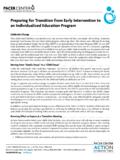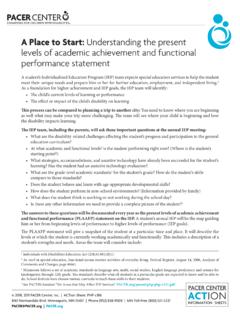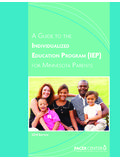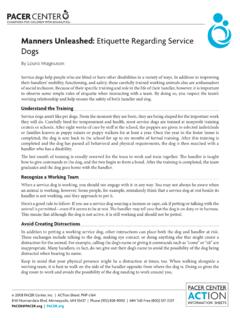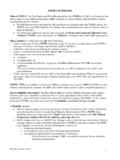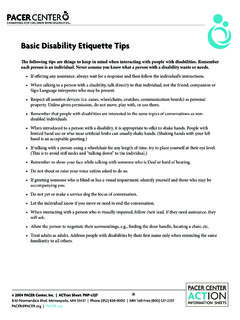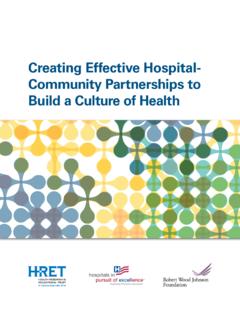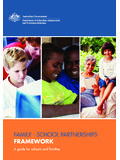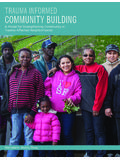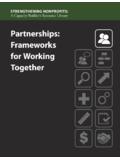Transcription of Supporting Parent, Family, and Community …
1 Supporting Parent, Family, and Community Involvement in Your School Deborah Davis June 2000. Northwest Regional Educational Laboratory Table of Contents ii Foreword ..iii What the Literature Tells Us About Parent and Family 1. Six Major Types of Partnerships Between Schools, Families, and Communities .. 2. Getting 4. Assembling the 4. Collecting 4. Using Data to Make Decisions about Priorities .. 5. Writing a Partnership Plan .. 5. Encouraging Positive Parenting Skills .. 6. Enhancing Communication with Families .. 8. Increasing Volunteerism And Attendance at School Events .. 10. Enhancing Learning at Home .. 12. Increasing the Number of Parents in Leadership and Decisionmaking Roles .. 14. Improving Community Collaborations.
2 16. Annotated Bibliography of Resources on Parent, Family, and Community 18. Appendix A: Measure of School, Family, and Community 25. Appendix B: Basic Information About Families Worksheet .. 33. Appendix C: Achievement Trends Worksheet (State testing information) .. 34. Appendix D: Achievement Trends Worksheet (Local testing information) .. 36. Appendix E: Evaluation 38. Appendix F: Family Opinion Sheet .. 39. i Northwest Regional Educational Laboratory 101 Main Street, Suite 500. Portland, OR 97204-3297. (503) 275-9500. 1-800-547-6339. e-mail Web site Planning and Program Development Dr. Steve Nelson, Director Comprehensive School Reform Demonstration Program Dr. David Zuckerman, Unit Manager June 2000. 2000 NWREL, Portland, Oregon Permission to reproduce in whole or in part is granted with the stipulation that the Northwest Regional Educational Laboratory is acknowledged as the source on all copies.
3 This publication was produced in whole or in part with funds from the Office of Educational Research and Improvement, Department of Education under contract # RJ96006501. However, the contents do not necessarily represent the policy of the Department of Education, and endorsement of the contents by the federal government should not be assumed. Acknowledgments NWREL wishes to acknowledge the following people for their editorial assistance: Editor Ms. Janice Wright Cover Design Ms. Denise Crabtree Reviewers Dr. Mark Buechler Ms. Jennifer Fager Ms. Barbara Hansen Ms. Jeann Harder Ms. Gretchen Van Hoet-Hill Ms. Betsy Hoag Ms. Kendra Hughes Ms. Donna Johnson Ms. Ida Settlemyer Ms. Ruth Taylor Dr. David Zuckerman Proofreaders Ms.
4 Elizabeth Blankenship Ms. Linda Fitch Ms. Linda Higgens Ms. Denise Jarrett-Weeks ii Foreword The family makes critical contributions to a child's achievement from early childhood through high school. Talking and playing with infants, reading bedtime stories with toddlers, playing math and reading games with elementary school students, helping middle school students with their homework, and establishing appropriate boundaries for teenagers are foundations for success in school. Many families, however, require assistance in providing these basics of a supportive home learning environment. When parents, families, and members of the Community are involved with schools, all children benefit. Adult participation sends the message that school is important and the work children do there is worthy of adult attention.
5 Many people, however, do not feel welcome at school. They may want to volunteer, but don't know how to begin. They may believe that children and teachers do not want them there, or they may not know how to fit one more activity into an already tight schedule. These situations present perfect opportunities for schools to reach out and provide avenues for parents, family members, and others to provide support. The family makes critical contributions to a child's achievement. Research regarding the effects of family involvement on educational outcomes has shown that parent involvement makes a difference in children's academic achievement. This guide provides ideas and suggestions taken from research on family and Community involvement in schools and can help school staff and others design a long-term approach to garnering the positive involvement of all concerned.
6 These ideas represent the tip of the iceberg of what is possible. There are as many solutions for creating a comprehensive plan to involve parents, families, and the Community in the education of children, as there are schools. Each school has its own demographic mix, Community context, and history. Following are ideas that can be modified and expanded upon to suit the needs of the school. iii What the Literature Tells Us About Parent and Family Involvement Studies of families show that what the family does with the children is more important to student success than family income or the education level of the parents. Parental participation improves student learning whether the child is in preschool or in the upper grades, whether or not the family is struggling economically or is affluent, or whether the parents finished high school or graduated from college ( Epstein, 1991.)
7 Henderson, & Berla, 1994; Liontos, 1992; Reynolds, et al., 1991; Zellman, , &. Waterman, , 1998). Both students and schools benefit from active participation by families in the process of educating children. The benefits for students when parents are actively involved in schools include: ! Higher grades and test scores ! Better attendance and more homework completed ! Fewer placements in special education ! More positive attitudes and behaviors ! Higher graduation rates ! Greater enrollment in post-secondary education (Clark, R., 1993; Griffith, J., 1996; Dauber, & Epstein , 1993). Parent involvement is more than good attendance at school-sponsored events or having a strong volunteer program. The strongest support for learning occurs at home through positive parenting styles, nightly reading, homework policies, and high expectations.
8 Schools that measure their success in reaching out to parents by the number of volunteers and attendance at workshops and meetings could be missing valuable opportunities to connect with families who can't be there or who are not comfortable coming to school (Epstein, J. et al., 1997;. Dornbusch, S. et al., 1987; Dauber, S., 1993; Comer, J. & Haynes, , 1992; Zellman, G., 1998). The need for strong family involvement starts by the time children are in preschool and continues through high school. As children grow older, the methods and expectations for family involvement must change and continue to evolve until graduation. Patterns of communication between families and the school as children enter middle school must be altered to accommodate multiple teachers and increased independence; nonetheless, parents remain valuable allies in increasing student achievement.
9 Schools have shown success by enlisting the support of parents in areas ranging from developing homework routines, providing after-school supervision, limiting television viewing, and helping children prepare for college and other post-secondary education (Eagle, E., 1989; Funkhouser, , & Gonzales, 1997; Scott-Jones, D., 1994; Goodman, J. et al, 1995; Sheilds, P., 1995). 1. Six Major Types of Partnerships Between Schools, Families, and Communities The Six Types of Partnerships Framework, developed by Joyce Epstein (1995) and her colleagues at Johns Hopkins University, is a useful model for analyzing and designing family-involvement programs. This framework describes the general categories of partnerships that exist between schools, families, and communities.
10 They are: ! Parenting: Helping families establish home environments to support children as learners ! Communications: The use of effective forms for school-to-home- and home- to-school communications ! Volunteering: The recruitment and organization of the school's volunteer program ! Learning at Home: Helping families assist their children with homework and recognizing other learning at home opportunities ! Decisionmaking: Including parents, students, and Community members in the school decisionmaking process ! Collaborating with the Community : The identification and integration of resources and services from the Community The Measure of School, Family, and Community Partnerships (Epstein, Salinas, Sanders, Davis, & Douglas, 1999) is based on the Six Types of Partnerships Framework and is included in this document as Appendix A.

